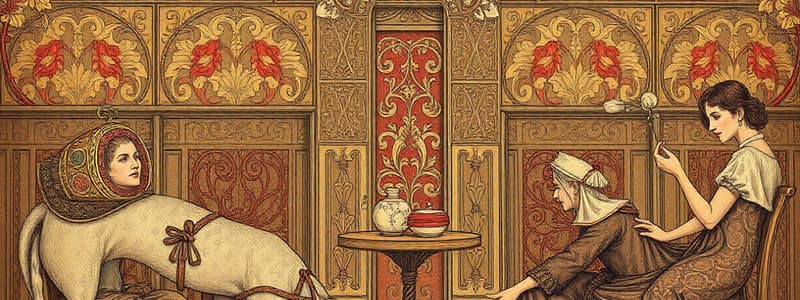Podcast
Questions and Answers
What is leadership?
What is leadership?
Leadership is the process of influencing others to guide and direct their behavior to achieve a common objective.
What is informal leadership?
What is informal leadership?
Informal leadership happens when an individual influences others without having formal authority, but still manages to guide and direct the behavior of the team.
What is coercive power?
What is coercive power?
Coercive power is the ability to influence someone's behavior through fear or punishment. It uses the threat of negative consequences to enforce compliance.
How may the Ohio State University Studies on Leadership be described?
How may the Ohio State University Studies on Leadership be described?
Signup and view all the answers
What is the difference between a job-centered manager and an employee-centered manager?
What is the difference between a job-centered manager and an employee-centered manager?
Signup and view all the answers
How may The Managerial Grid be described?
How may The Managerial Grid be described?
Signup and view all the answers
What is assumed under the contingency theories of leadership?
What is assumed under the contingency theories of leadership?
Signup and view all the answers
Under Fiedler's contingency leadership model, what factors are used to determine how favorable the leadership environment is?
Under Fiedler's contingency leadership model, what factors are used to determine how favorable the leadership environment is?
Signup and view all the answers
What major roles are involved in the path-goal model of leadership?
What major roles are involved in the path-goal model of leadership?
Signup and view all the answers
What could be the reason why Ernie is not very successful in his current position as a leader?
What could be the reason why Ernie is not very successful in his current position as a leader?
Signup and view all the answers
What must Ernie do to be more effective?
What must Ernie do to be more effective?
Signup and view all the answers
Study Notes
Human Behavior in Organizations
- Leadership is a critical factor in organizational success, as evidenced by historical and business examples
- Leadership is defined as the process of guiding and directing people's behavior to achieve organizational objectives
- Effective leadership can overcome resource limitations, inspire performance, and ensure alignment with organizational goals
- Leading is a management function, alongside planning, organizing, and controlling
- Management focuses on efficiency, while leadership emphasizes vision and motivation
- Managers are problem-solvers, often focused on procedures, while leaders are more visionary and intuitive
- Leaders are focused on achieving results, while managers manage functions
Leadership
- Leadership is fundamentally important for organizational success
- Leaders like Lincoln, Caesar, and Disney are historical examples
- Leadership is the process of guiding and directing behavior for strategic objectives
- Leaders determine the difference between the success or failure of an organization.
- Leadership helps motivate people to achieve organizational goals and behave effectively.
Kinds of Leadership
- Formal leadership: involves official objectives with formal authority, using reward, coercive, referent, and expert power.
- Informal leadership: focuses on unofficial objectives, lacking formal authority relies on the same influencing power types as formal leaders
Power and the Leader
- Leaders leverage power to influence behavior
- Power can come from either the leader or the team/group.
- Power can be classified into position power and personal power
Position Power
- Legitimate power: arises from the leader's position in the organization (authority to command)
- Reward power: comes from the leader's ability to give rewards for compliance.
- Coercive power: comes from the leader's ability to punish for non-compliance.
Personal Power
- Expert power: stems from a leader's knowledge and specialized skills in a particular domain
- Referent power: arises from the personal characteristics and influence of the leader, creating a personal magnetism.
Theories of Leadership
- Trait theories: focus on common characteristics like sociability, persistence, and intelligence that successful leaders possess.
- Behavioral theories: identify specific behaviors that distinguish leaders from non-leaders.
- Contingency theories: emphasize that the most effective leadership style is dependent on the situation. Leadership styles should match the circumstances, team/group and/or the task
Ohio State University Studies
- Identified two primary dimensions of leadership:
- Initiating structure: how leaders define their roles and the roles of subordinates.
- Consideration: the degree to which leaders create a friendly and supportive work environment.
University of Michigan Studies
- Found two styles of leadership:
- Job-centered: leaders who are focused on tasks and controlling procedures
- Employee-centered: leaders who are supportive and focus on team member motivations
Yukl Studies
- Identified 19 leadership behaviors
Managerial Grid
- Created by Blake and Mouton, this is a two-dimensional graphical model of leadership styles
- Focuses on managers' concern for both people and production.
Contingency Theories
- Continuum of Leadership Behavior – Tannenbaum & Schmidt : shows seven alternative styles of management decision making.
- Contingency Leadership Model – Fiedler : leadership style matches environmental favorability (leader-member relations, task structure, and position power) to either a task-oriented or relationship-oriented style.
- Path-Goal Model – House & Mitchell : style of management helps followers reach goals.
- Hershey-Blanchard Situational Leadership Theory : style is matched with the subordinate’s readiness/maturity—a willingness and ability to perform the task
- Leader-Member Exchange Approach: emphasizes the importance of leader-member interactions.
- Normative Decision Model: determines the ideal decision-making style given specific factors
- Muczyk-Reimann Model: four types of leadership styles are offered
Studying That Suits You
Use AI to generate personalized quizzes and flashcards to suit your learning preferences.
Related Documents
Description
Explore the vital role of leadership in organizational success through historical examples and key concepts. Understand the differences between management and leadership, and how effective leadership can inspire teams and achieve strategic objectives. This quiz will test your knowledge on the principles of leadership and its impact on organizations.




